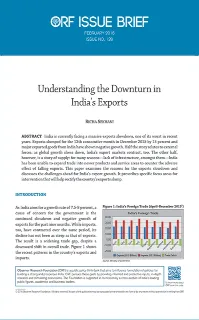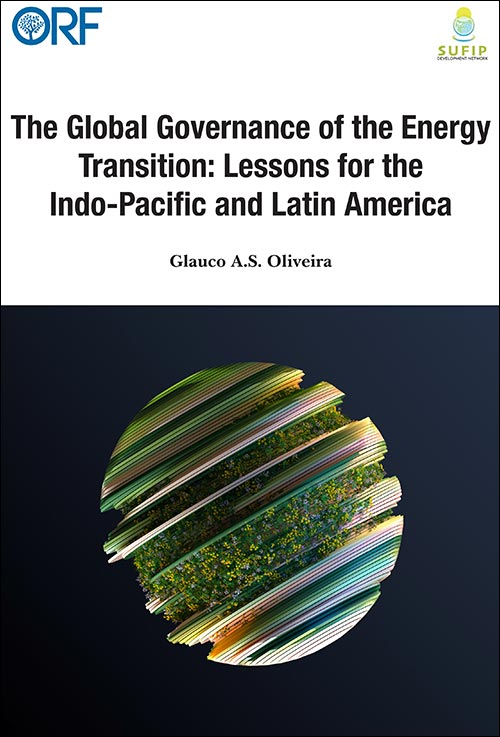INTRODUCTION
As India aims for a growth rate of 7.5-8 percent, a cause of concern for the government is the continued slowdown and negative growth of exports for the past nine months. While imports, too, have contracted over the same period, its decline has not been as steep as that of exports. The result is a widening trade gap, despite a downward shift in overall trade. Figure 1 shows the recent patterns in the country's exports and imports.
Figure 1: India's Foreign Trade (April-December 2015)

Source: Ministry of Commerce
The fall in India's exports has been seeing a progressive pattern, setting off alarm bells as exporters are now demanding intervention from both the central government and the commerce ministry. After all, the sluggishness in exports has hit almost all significant industries including leather and leather goods, iron ore, and electronics. It is expected that India's exports will decline by 13 percent to $270 billion in the current fiscal year.
The bulk of the fall in exports from April to December 2015 comprises some important commodities like cereals (with a decline of 71.4 percent), petroleum products (48.8 percent), and 2 iron ore (69.3 percent). The fall in exports of gems and jewellery, India's largest exports segment, was more restrained, with the outflows declining by 9.33 percent. Meanwhile, engineering goods registered a fall of 15 percent during the same period. Though other commodities saw growth-such as meat and dairy products, tea, jute and handicraft-the evidence show that some important segments continue to record a sharp decline. The fall therefore has not only been prolonged, but it is also severe and fairly broad-based, as it is not restricted to merchandise exports and extends to services exports as well.
Table 1 details the s elected major commodities which have seen either positive or negative trends of growth in April to December 2015.
Table 1: Trade: Exports3

Source: Ministry of Commerce
A main reason for the exports slowdown is the lethal combination of an overall, global economic slowdown and the weakening of competitor countries' currencies. At the same time, however, the exports decline can also be blamed on India's own lack of competitiveness and its inability to 4 hold up amidst these forces. For one, even after years of supposed reforms, India continues to export the same products to largely the same markets and as a result, trade has not seen a lateral nor horizontal shift. Moreover, manufacturing-which constitutes more than 60 percent of India's merchandise exports-has stagnated in its composition. Despite having several advantages in high-value-added manufacturing including engineering skills, a growing domestic market, a raw material base and a large pool of skilled labour-India's share in exporting these high-value-added products remains low. Gems and jewellery, textiles and clothing, chemicals and related products, still have only a 50-percent share in overall manufacturing exports, the recent overall trend of which has also been downward. Rectifying the situation is an imperative, especially as India is keen to promote itself as a hub of global manufacturing through its flagship 'Make in India' programme.
EXPORTS DECLINE: IMPACT ON THE ECONOMY
Falling exports bodes ill for India's macroeconomy. Exports as a percentage of Gross Domestic Product (GDP) have fallen from a high of 16.8 percent in 2011-12 to 15.4 percent in 2014-15.5 The fall in exports has significant repercussions not only on growth but also on the present government's much hyped, 'Make in India' programme. Analysts estimate that the fall in exports is likely to cause a reduction in GDP by two percent.6 As a result, the revised forecast of a 7.6-percent growth rate for the current fiscal year has become unlikely; the more probable rate for 2016 is pegged at 5.6 percent. This less-thanoptimal growth rate is expected to create a ripple effect on the 'Make in India' campaign, which aims to transform the country into a global manufacturing hub. According to official data, the export of commodities that are closely linked with 'Make in India'-including engineering goods, electronic goods, and organic and inorganic chemicals-has seen a decline of 14.9 percent, 8.75 percent and 8.82 percent, respectively.
Another sector which will likely be affected by falling exports is the manufacturing sector which, in turn, will create a negative impact on the employment of labour. Currently, the impact of poor merchandise exports has been visible in the manufacturing segment, where capacity utilisation levels have steadily dipped each quarter. According to official reports released in 2015, the slack in manufacturing is resulting in labour issues as well, with exporters forced to shut their manufacturing units. According to a survey by the Labour Ministry for the period April to June 2015, net job creation declined by 43,000; export-oriented companies accounted for 26,000 of the net fall. During the same period, merchandise exports in India declined by 16.75 percent.7 A significant decline was observed in the cotton yarn industry, which saw job losses of a staggering 3.5 lakh people in the last one year. Similarly, in the metals sector, already severely hit by global deflationary forces, the incidence of layoffs and retrenchments increased. A slowdown in employment will further hit the income growth, affecting the aggregate consumption in turn, to the extent that it will offset or subdue the boost that private consumer spending is otherwise gaining from lower prices of fuel and other goods.8
Another channel through which falling exports can impact the macroeconomy is by putting stress on external balances, leading to intensification of current account deficit. Secondly, the pressure from shrinkage and retreat of global capital flows from emerging markets could lead to depreciation pressures upon the exchange rate. It is thus extremely important that India's policymakers examine and analyse the factors responsible for the country's declining exports. Intervention is needed to prop up the sectors facing a downward trend.
FACTORS STIFLING EXPORTS
Both demand- and supply-side factors are creating a negative impact on India's export volumes. The imperative is for strategies to reverse the impact of these factors.
Depressed Demand
One of the most significant factors causing the ongoing decline in India's exports is the weakening of global demand. A large proportion of India's exports go to OECD countries, in particular to the US, the EU, and Japan. However, the continuing impact of the global financial crisis, as evidenced from the constant downward revision in the International Monetary Fund's (IMF) global growth figures since 2011, means that demand stimulus from India's traditional trading partners will remain muted and may not be able to pull back India's export growth.
Similarly, while South-South trade has continued to increase as a percentage of global trade, India cannot hope to counter the depression of demand from the North by rebalancing trade relations with its Southern trade partners. This is because emerging markets, in particular the BRICS nations, responsible for a large part of the growth in South-South trade, are now themselves struggling with the consequences of the Chinese economic slowdown and the devaluation of the Yuan. For India, 50 percent of its exports go to the developing countries. When incomes of these developing countries are affected by their low exports to China, they may reduce their imports from India as well. Thus, the connection between China's own slowdown and its impact on the Indian economy comes through the third party; its consequences will be seen on the economic growth of India. As S C Ralhan, president of the Federation of Indian Export Organisations (FIEO) said, "We are facing terrible times as orders from the US and Europe has dried up. The slowdown in China and depreciation of its currency has further hit exports." The Yuan devaluation has made Chinese exports even more competitive, and they continue to flood world markets and, in particular, India. Ralhan also noted that total merchandise exports could fall to about $250 billion in the fiscal year ending March 9 31. Further, appreciation in the 'real effective exchange rate' of the rupee-at a time when China, Russia and Brazil have either devalued or allowed a significant depreciation of their respective currencies-has increased the exporters' woes.
Another important factor which is affecting India's exports is the decline in the global commodities and crude oil prices. Analysts predict that with the lifting of sanctions from Iran, supply of crude will increase, leading to the further fall in the prices of commodities. Commodities and crude oil prices have more than a 40-percent bearing on India's exports. Slumping commodity price and crude oil price would have been a boon for India, which relies heavily on oil imports to service its energy needs. However, closer analysis indicates that India is at a disadvantage. A sharp drop in commodity prices has led to the decline in the value of the exported items of India, thereby affecting earnings. For instance, weak prices of agricultural products have affected earnings of the agricultural producers. Similarly, the fall in crude prices has affected the dollar earnings from exports of refined petroleum products like diesel and petrol. According to Deutsche Bank, the export value of refined fuel-which makes up one-fifth of India's total exports-went down by 51 percent last year.10
As India is well integrated with the world economy, the global slowdown-of which the Indian government has no control-will continue to affect the country's economy. Issues surrounding the supply side must thus be given immediate attention, if India aims to revitalise its exports and utilise the sector to fulfil overall economic-growth goals.
Constrained Supply
Beyond depressed demand factors, it is supply-side constraints that have created a negative impact on India's ability to expand trade into newer products and service areas and counter the effect of falling exports.
To begin with, export-oriented production requires significant infrastructure support. However, India is facing crippling infrastructure shortages which include the most important, power and roads, due to low investment in those sectors. Investments through the public-private partnership (PPP) mode have also fallen short, leaving the government with few options. According to data compiled by Mckinsey & Company, the average infrastructure investment in India during the period 1992-2010 constituted only 4.7 percent of GDP as against 7.3 percent across countries like China, Indonesia, and 11 Vietnam. Reaching a peak of 24 percent in the last quarter of 2009-10, the rate of gross capital formation has plummeted to zero in the third quarter of 2014-15. Indeed, the 2014 World Economic Forum Global Competitiveness Report ranked India 85 out of 144 countries in terms of infrastructure quality, noting its "inadequate supply of infrastructure". The report listed such 12 factor as 'most difficult' in doing business. This internal, supply-side constraint is, to a huge extent, responsible for containing India's exports growth.
The inefficiency in logistics compounded by weak trade facilitation regime is another factor that is raising the cost of exports considerably and, in turn, making India's manufacturing exports less price-competitive. India's over-dependence on road freight means that the cost of logistics as a percentage of GDP remains as high as 13-14 percent, compared with seven to eight percent in developed countries.13 The obvious-and more efficient-alternative is rail transport. India can easily be compensated by the export incentives of two to three percent of the export value, if additional costs due to inefficient trade infrastructure are avoided with appropriate policy intervention.
Another area of concernimpeding manufacturing output is India's outdated labour laws, which make it difficult for businesses that face seasonality in their demand to retrench their workforce according to market fluctuations. While the Ministry of Labour has brought some reform proposals in recent months, the government needs to ensure that it is going ahead with these much needed reforms. Slow implementation of policies has done more to dissuade investment than the extant labour laws. Government needs to continue its thrust on addressing challenges in these areas, including lack of access to credit, inadequate infrastructure and high transport costs, low availability and high cost of inputs, and difficult and limited access to land.
There is also the matter of non-tariff measures and procedural obstacles. These hurdles are related to licensing, permits to export, inspections, certificates and taxes. Further, there are obstacles from the importing country such as standards and conformity assessments, and rules of origin and preshipment inspections-all of which are hurdles to exporters, especially of the Micro, Small and Medium Enterprises (MSME) kind. Despite being part of the trade pacts and having signed Free Trade Agreements (FTAs) on both bilateral and multilateral levels, India has failed to negotiate for improved market access for the country's exports. Most of the trade pacts that India has signed are more for geopolitical reasons than commercial ones. Further, India's preferential trade agreements (PTAs) are regarded by analysts as 'shallow' in terms of product coverage, implying that India has failed to utilise PTAs for export promotion.
INTERVENTION AREAS: WAY FORWARD
India's competitiveness, on both cost and efficiency of production, lags behind that of rival China and some other developing country exporters. The reasons for this are both structural and informational. Indian companies require the requisite infrastructure, still sorely lacking in comparison to its trade competitors, to allow product export prices to be globally competitive. Further, the cost of capital in India remains too high for companies to be able to borrow competitively. While the Reserve Bank has made commendable progress in inflation targeting, there needs to be a sustained period of contained inflation for bank rates to come down to levels where companies feel comfortable accessing debt for working capital needs. Sustained efforts are thus needed to tackle the steady decline of exports.
Encourage Export-Oriented Foreign Direct Investment (FDI)
In general, companies that are looking to invest in India often have their eyes set on the large domestic consumption market. Policies supporting export-oriented manufacturing zones need to be given more attention. Further, norms on FDI can also be differentiated so as to have schemes that incentivise investments geared towards generating exportable goods and services.
Integrating into Global Value Chains (GVCs)
Alongside enabling infrastructure and cheaper capital, Indian firms need to recalibrate their production strategies to become a part of GVCs of production. With globalisation, corporations expanded their manufacturing activities across the globe, and created global supply chains to integrate their distributed manufacturing. However, Indian firms are not integrated into the global production of intermediate goods, which today form the bulk of trade across GVCs. Further, India's weak intellectual property regime (IPR) has acted as an obstacle for technology transfer from foreign firms to India. In order to become a part of GVCs, India needs to establish a stronger IPR regime and create supply-chain efficiencies.
Boosting Defence Manufacturing and Exports As part of the push to increase manufacturing output, the government needs to take substantive steps towards establishing a strong defence industrial base in the country with world-class manufacturing capabilities leading to strong export possibilities. This requires continued actions to release capacity and informational bottlenecks that restrict the participation of the private sector in defence manufacturing.
Developing State -Specific Export Strategy
The Government of India, and in particular the Ministry of Commerce and its affiliate bodies, need to enhance interaction with State Governments, with a view to building an understanding of the comparative advantages enjoyed by states in the production of certain goods and services. Every State government must be mandated to come out with its own 'Export Strategy' document. The central government also needs to educate the state government about enhancing Trade Facilitation (TF) infrastructure, while concurrently improving the ease of doing business norms so that entrepreneurs and business can focus on improving products and services instead of focusing on compliance and administration.
Fixing Trade Regime through FTAs
Fixing India's trade regime should be top priority for the government. India's ill-conceived trade pacts have resulted in inverted duty structures that discourage the production and exports of value added items such as apparel and finished products like laptops or mobile phones. Further, India needs to negotiate on the market access and tariff and non-tariff barriers issues with its Asian partners including China, Korea, Japan and Indonesia to penetrate their markets more easily. Also, India is presently going slow on trade pacts like the one with European Union that could be immensely beneficial, especially in the context of the signing of the Trans-Pacific Partnership (TPP), of which India is not a member. Analysts predict that India will face difficulties in trade as a result of the TPP, for example, its textile industry. India thus needs to play a more judicious role in negotiating FTAs with its trading partners and aim to encourage the exports industries.
CONCLUSION
Reviving India's exports is necessary if India wants to achieve its growth targets. The 'Make in India' policy-aimed at creating jobs for the rapidly expanding workforce in India's organised manufacturing sector by enhancing exports-has undoubtedly sent signals of vigour and enthusiasm, both domestically and to the international community. However, India should be conscious of the fact that the window of growth through export-led manufacturing is limited and thus should not be missed, as the costs of failure are now greater than ever. Building productive capacities to enhance competitiveness, market linkages and enhancing investment attractiveness in selected sectors will have a strong impact on the export capacity of Indian business and will improve the country's trade balance.
Tackling the sluggishness in India's export sector is demanding a mix of trade strategy as well as radical policies and reforms. This will help the country revitalise its exports growth, a feat it managed during the global boom years of 2000 to 2007, when the country's exports surged 20 percent a year.14
Endnotes
1. India's Foreign Trade: Press Release, Ministry of Commerce, January 18,2015. http://commerce.nic.in/ tradestats/PressRelease.pdf.
2. Director General of Commercial Intelligence and Statistics, Ministry of Commerce and Industry, 2015.
3. Ibid.
4. Renu Kohli, "Falling exports complicate the macro", Live Mint, October 20, 2015, http://www.livemint.com/Opinion/P6uyLn00mQojnEDWSdv1WN/Falling-exports-complicate-themacro. html.
5. Pyaralal Raghavan, "Falling exports will derail the Make in India efforts and slowdown GDP growth rates", The Times of India, September 16, 2015, http://blogs.timeso-ndia.indiatimes.com/minorityview/fallingexports- will-derail-the-make-in-india-efforts-and-slowdown-gdp-growth-rates/.
6. Geethanjali Nataraj & Mridul Mohan, "Exports on a slippery slope", The Hindu Business Line, October 15, 2015, http://www.thehindubusinessline.com/opinion/exports-on-a-slippery-slope/article7766488.ece.
7. Neeraj Thakur, "Lost jobs, shut factories: India's dark export story", Catch News, December 18, 2015. http://www.catchnews.com/business-economy-news/lost-jobs-shut-factories-india-s-dark-export-story- 1450390335.html.
8. Renu Kohli, "Falling exports complicate the macro," Live Mint, October 20, 2015, http://www.livemint.com/Opinion/P6uyLn00mQojnEDWSdv1WN/Falling-exports-complicate-themacro. html.
9. ENS Economic Bureau , "December Trade Deficit widens to $11.6 Billion as Exports Shrink", The New Indian Express, January 21, 2016,http://www.newindianexpress.com/business/news/December-Trade-Deficit- Widens-to-11.6-Billion-as-Exports-Shrink/2016/01/19/article3233304.ece.
10. Ansuya Harjani, "Commodities collapse a catch-22 for India", CNBC, September 27, 2015.
http://www.cnbc.com/2015/09/27/commodities-slump-offset-by-weak-india-domestic-demand.html. 11. NITI Brief, "Investment in Infrastructure: Strengthening PPP Policy framework", NITI Aayog, http://niti.gov.in/mgov_file/NITI%20Brief5.pdf.
12. Klaus Schwab, "The Global Competitiveness Report 2014-2015", World Economic Forum, http://www3.weforum.org/docs/WEF_GlobalCompetitivenessReport_2014-15.pdf.
13. Ritesh Kumar Singh, "What's Behind India's Big Export Decline?", The Diplomat, November 6, 2015. http://thediplomat.com/2015/11/whats-behind-indias-big-export-decline/.
14. Ibid.
The views expressed above belong to the author(s). ORF research and analyses now available on Telegram! Click here to access our curated content — blogs, longforms and interviews.

 PDF Download
PDF Download





 PREV
PREV


